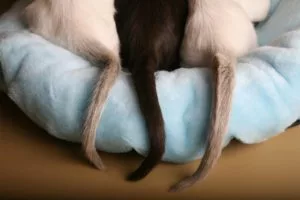Cat Tail Twitching: What Does it Mean?
Have you ever seen your cat flick or twitch its tail? Cats are such mysterious creatures and communicate in unique ways. It can be hard to understand what a cat wants or feels from its actions, but it is not impossible. Although it is difficult, we have some ideas on what your cat’s body movements indicate, especially when it comes to tail twitching.
When your cat’s tail twitches, it could indicate a variety of different things! You need to analyze all of your cat’s body language and vocalizations to understand exactly how they are feeling or what they are trying to say when they flick or twitch their tail.
When a cat flicks, swishes, or twitches its tail, it is usually a sign that the cat is alert and focused, angry and stressed, or scared and nervous.

Alert and Focused
When your cat twitches their tail, it could be a sign that they are paying close attention to something that has interested them. This tail twitch usually comes in a side to side motion, and can be both fast and aggressive or slow and smooth.
For example, if your cat looks outside sees a bird, squirrel, or even a leaf blowing in the wind, you’ll notice them watching the scene intently. If you focus on their tail, you will see your cat twitching it from side to side. This is a key indicator that they are alert and focused on something that has caught their attention!
Remember, cats are natural-born predators, so it is perfectly normal for your cat to peer outside through the window or door at birds, squirrels, and other small animals. However, letting your cat outside unleashed and unsupervised can lead to a variety of problems for you and your cat.
Anger and Stressed
One particular meaning that your cat is trying to display as they twitch their tail is anger. It is a warning sign to you or something around you that they are irritated. They may also hiss or growl as they twitch, swish, or flick their tail back and forth. The tail movement is smooth and quiet.
How do you know when they are feeling stressed, though? Cats will also make direct eye contact and some noises of irritation. Not all cats hiss, though. Instead, they may breathe heavier and stare directly at you. It is a warning to let go.
Scared and Nervous
Cats may show fear by their tail behavior. When a cat gets scared or nervous, they may swish, flick, or twitch their tail back and forth while tucking their ears down. This swish, flick, or twitch of the tail will usually come in a slow, almost stagnant, motion.
Although they are still moving their tail, it is almost as if they are moving it so slow that they don’t want whatever is scaring them or making them nervous to see the movement. It is as if they are in the wild, almost at a dead stop, hiding from a predator!
What to Do If Your Cat’s Tail Twitches
While it is normal to stress and feel bad for our friendly cats, there is not much we can do when they twitch their tail. Since this can be used as a warning, you should back down if your cat is showing you additional body language signs such as growling, hissing, or staring.
However, not all things are worth backing down from. For example, if you are trying to groom them and they are upset by your actions, it is not your fault! While you can stop grooming them, this will only let them know they are getting away with the action!
Instead, try and soothe your cat from their stress. You can even turn this into a teaching moment if you need to! Pet your cat and give them a treat as they start to cool down during the task. Only stop if they are extremely distressed and trying to scratch you or themselves.
If they are hunting or playing, let them be! This is normal behavior and lets them release pent-up energy, which is essential, especially for kittens that are excited! Instead, you can encourage playtime by providing your cat with toys and burning their energy. They love to chase and play; it is best to get a toy hanging on a string. It is also fun to watch them jump up high and catch the ‘mouse’ at the end of the string.
Conclusion
Overall, cats are not easy to understand. These small feline friends like to use different forms of body language to communicate and show different moods and emotions. Just like how humans and other animals use body language consciously and subconsciously, cats use twitching, swishing, or the flicking of their tail when they are feeling a certain emotion.
Remember though, it is hard to tell how your cat is feeling simply by them flicking or twitching their tail. The real tell is what body language they are expressing as they move their tail. An angry or stressed cat will hiss, growl, or stare at you while their tail moves. A scared or nervous cat will tuck their ears back, while one that is focused and alert will dip their head down at or below shoulder level, like they are about to pounce!
Fortunately, a cat twitching its tail is nothing to be worried about. However, if you have any questions or concerns, Whitney Veterinary Hospital in Peoria, IL, can be reached at (309) 685-4707!
